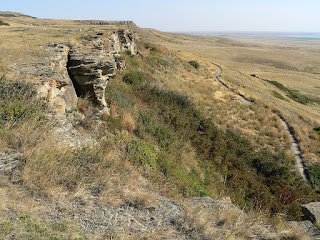What Is: A Buffalo Jump
One of the more dramatic scenes of Dances With Wolves is the buffalo hunt, with Lakota warriors (and Kevin Costner), chasing a herd of buffalo across the prairie shooting with bows and arrows (and a rifle/carbine) as the women of the tribe hurried to begin the process of dressing the fresh meat. Such hunts were possible after Plains tribes acquired the horse from Spanish traders and integrated it into their cultural practice, but bison have been an integral part of Native life long before the horse. How did hunts happen before then 18th century?
Plains tribes relied on landmarks known as buffalo jumps. These were cliffs, bluffs or other precipices sharp enough and steep enough that buffalo could be stampeded off them with a sure chance of breaking legs or necks and becoming incapacitated long enough to be finished off with arrows or spears. Each tribe knew where in their hunting range such buffalo jumps could be found. They also took advantage of the terrain to create pathways to act as chutes for driving the buffalo up to the precipice. Lewis and Clark were among the first White men who heard descriptions of this practice, though no White men was ever documented as actually seeing it performed. According to what Lewis later recorded in his journal, once a herd was spotted, a younger warrior would disguise himself with a buffalo robe to attract the attention of the buffalo. Others of the tribe would crowd the buffalo toward the precipice and cause a stampede. The young man would then hide or run as the panicked herd ran toward and off the edge. Below, other warriors would finish off the floundering animals with arrows or spears. The Blackfoot called the melee below the cliff the "pishkun" or deep blood kettle.
Once the animals were killed, the work of dressing and preserving the meat kicked into high gear, with special camps set up near the buffalo jump for the purpose of processing the kills. Every hide, bone, sinew and tissue of a bison had its purpose. Hides were lodge covers, clothing and carrying receptacles. Bones were tools and cooking implements. Sinews were bowstrings. Bladders were water carriers. The meat would be hung in strips to dry, pounded to make pemmican or preserved in hide carrying cases made for the purpose. A single buffalo could keep a Native family in food and clothing for months, which is why the idea of the wasteful killing of these animals by White hunters became even more tragic.
Plains tribes relied on landmarks known as buffalo jumps. These were cliffs, bluffs or other precipices sharp enough and steep enough that buffalo could be stampeded off them with a sure chance of breaking legs or necks and becoming incapacitated long enough to be finished off with arrows or spears. Each tribe knew where in their hunting range such buffalo jumps could be found. They also took advantage of the terrain to create pathways to act as chutes for driving the buffalo up to the precipice. Lewis and Clark were among the first White men who heard descriptions of this practice, though no White men was ever documented as actually seeing it performed. According to what Lewis later recorded in his journal, once a herd was spotted, a younger warrior would disguise himself with a buffalo robe to attract the attention of the buffalo. Others of the tribe would crowd the buffalo toward the precipice and cause a stampede. The young man would then hide or run as the panicked herd ran toward and off the edge. Below, other warriors would finish off the floundering animals with arrows or spears. The Blackfoot called the melee below the cliff the "pishkun" or deep blood kettle.
Once the animals were killed, the work of dressing and preserving the meat kicked into high gear, with special camps set up near the buffalo jump for the purpose of processing the kills. Every hide, bone, sinew and tissue of a bison had its purpose. Hides were lodge covers, clothing and carrying receptacles. Bones were tools and cooking implements. Sinews were bowstrings. Bladders were water carriers. The meat would be hung in strips to dry, pounded to make pemmican or preserved in hide carrying cases made for the purpose. A single buffalo could keep a Native family in food and clothing for months, which is why the idea of the wasteful killing of these animals by White hunters became even more tragic.




Comments
Post a Comment